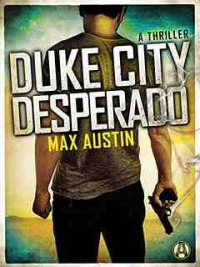Duke City Desperado by Max Austin
 Wednesday, August 12, 2015 at 10:16AM
Wednesday, August 12, 2015 at 10:16AM 
Published by Alibi on June 9, 2015
The Duke City novels combine believable but offbeat characters with fast-moving crime plots. Max Austin (the pen name Steve Brewer uses for these novels) always manages to give crime an amusing spin. Duke City Desperado is a little funnier and a little less poignant than the first two, but however Austin chooses to strike that balance, this series of Albuquerque crime stories is maintaining its high quality. I particularly like the fact that each novel focuses on a different character. That choice should keep the series fresh.
Dylan James is a trouble magnet. When he rabbits from a stolen van that his sky-high friend Doc Burnett uses in an attempt to rob a bank from a drive-through window, he begins life as an Albuquerque fugitive, a wanted desperado. His first stop is the house of his ex-girlfriend, who is now dating a tough guy named Antony. Then he meets Katrina ("like the hurricane"), a college student who is fascinated by crime.
Eventually Dylan is being chased by the police and the FBI, by Antony, and even by Katrina, while Antony is being chased by the sister of Dylan's ex-girlfriend, who does not appreciate the way Antony treats women. The sister is joined by a formidable group of women who wield footwear as weapons. A focal point for much of the action is the apartment of Dylan's stoner friend, whose attempts to play video games while maintaining a steady high are constantly interrupted by people who are looking for Dylan. The lighthearted hijinks that ensue (including Doc's antics as a federal prisoner) are consistently funny. Throughout the novel and particularly as it neared the end, I experienced a number of laugh-out-loud moments.
What I really like about these novels is their recognition that a good bit of crime is stupidly impulsive, that everyone deserves a fresh start (or nearly everyone), and that separating the good guys from the bad guys is often a matter of opinion. Austin's rogues are always affable, regular people whose lives have been dictated by unfortunate circumstance and bad choices but who never let go of their humanity. The plots are just as likable as the characters. Like the other novels in the series, Duke City Desperado is a light diversion from the usual darkness of crime stories.
RECOMMENDED



